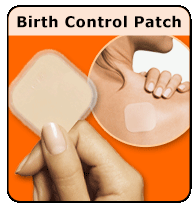Birth Control: The Patch
What Is the Birth Control Patch?
The birth control patch is a thin, beige, 1¾-inch (4½-centimeter) square patch that sticks to the skin. It releases hormones through the skin into the bloodstream to prevent pregnancy.
How Does the Birth Control Patch Work?
The combination of the hormones progesterone and estrogen in the patch prevents ovulation (the release of an egg from the ovaries during the monthly menstrual cycle). If an egg isn't released, pregnancy can't happen because there's nothing for the sperm to fertilize.

The hormones in the patch also thicken the cervical mucus (the mucus produced by cells in the cervix). The cervix is the part of the uterus that sits within the vagina and acts as the opening to the uterus. The thickening of cervical mucus makes it difficult for sperm to enter the uterus and reach any eggs that may have been released. The hormones in the patch can also sometimes affect the lining of the uterus so that if the egg is fertilized it will have a hard time attaching to the wall of the uterus.
Like other birth control methods that use hormones, such as the birth control pill or birth control ring, the birth control patch is used based on the monthly menstrual cycle. A female applies the patch on the first day of her menstrual cycle or the first Sunday after her menstrual cycle begins. She will change the patch on her skin once a week for 3 weeks in a row. (The patch should be applied to one of these four areas: the abdomen, buttocks, upper outer arm, or upper torso — except for the breasts.) On the fourth week, no patch is worn, and the menstrual period should start during this time. It's important to use an additional form of contraception during the first 7 days on the patch to prevent pregnancy.
A new patch should be applied on the same day every week to make sure that it keeps working effectively. For example, if the first patch is applied on a Monday, patches should always be applied on a Monday. When it's time to change the patch, the old one should be pulled off first, before applying a new patch. The new patch should be placed on a different area from the old patch (but still on one of the four recommended areas) to avoid skin irritation. And any skin that is red, irritated, or cut should be avoided.
If a patch becomes loose and falls off or if someone forgets to apply a new patch on the right day, she should check the labeling information or a doctor about what to do. A backup method of birth control may be necessary for a while, such as condoms, or she might need to stop having sex for a while to protect against pregnancy. Also, if someone stops using the patch for any reason, they will need to begin using another method of birth control, usually 24 hours after removing the last patch.
It's OK to do regular activities like swimming and exercise while wearing the patch. It can also get wet in the shower or in the bath. But the patch should not be moved or removed until the week is over (pulling the patch off to reposition or move it may cause it to lose some of its stickiness and it might fall off easily). If the patch does not stick well, a replacement patch should be applied. Someone wearing a patch shouldn't try to change its size by trimming it or try to attach it with tape.
The patch should not be applied over makeup, creams, lotions, powder, or other skin products as these may prevent it from sticking well. (Skin products may also affect how hormones are absorbed by the skin.)
A removed patch should be folded in half with the sticky sides facing each other (to prevent the chemicals from getting into other items in the trash and going to the soil) and thrown away (not flushed down the toilet).
How Well Does the Birth Control Patch Work?
Ongoing studies suggest the birth control patch is as effective as the birth control pill. That means that about 9 out of 100 couples will have an unintended pregnancy during the first year of use. Of course, the chance of pregnancy depends on using the patch correctly. Delaying or missing a weekly application or removing a patch too early reduces its effectiveness and increases the chance of pregnancy.
For someone who weigh more than 198 pounds (90 kilograms), the contraceptive patch may be less effective in preventing pregnancy. Some health conditions and medicines also might interfere with the patch. How effective the patch is also depends on whether it's convenient to use and worn all the time.
Does the Birth Control Patch Help Prevent STDs?
The birth control patch does not protect against sexually transmitted diseases (STDs). Couples having sex must always use condoms along with the birth control patch to protect against STDs.
Abstinence (not having sex or any type of intimate genital contact) is the only method that always prevents pregnancy and STDs.
Are There Any Problems With the Birth Control Patch?
The birth control patch is a safe and effective method of birth control. Most people who use the patch have no side effects. Smoking cigarettes while using the patch can increase the risk of certain side effects, which is why health professionals advise those who use the patch not to smoke.
Side effects from the patch are similar to those from the birth control pill. These may include:
- irregular menstrual bleeding
- nausea, headaches, dizziness, and breast tenderness
- mood changes
- blood clots (rare in those under 35 who do not smoke, but there may be a higher risk with the patch than with the Pill)
Other possible side effects seen in patch users include:
- skin reactions at the site of application of the patch
- problems with contact lens use, such as a change in vision or inability to wear the lenses
- menstrual cramps
Many of these side effects are mild and tend to disappear after 2 or 3 months.
Who Is the Birth Control Patch Right for?
The birth control patch may be a good choice for someone who's sexually active, weighs less than 198 pounds (90 kilograms), and has trouble remembering to take a pill every day or trouble swallowing pills.
In some cases, medical or other conditions make the use of the patch less effective or more risky. For example, it is not recommended someone who's had blood clots, severe high blood pressure, some cancers, certain types of migraine headaches, or diabetes with certain complications. Anyone who has unexplained vaginal bleeding (bleeding that's not during their periods) or who think they may be pregnant should talk to their doctors, discontinue using the patch, and use another form of birth control in the meantime.
Where Is the Birth Control Patch Available?
A doctor or a nurse practitioner (NP) must prescribe the patch. They'll ask about a girl's health and family medical history, and may do an exam, including a blood pressure measurement and, possibly, a pelvic exam.
If the patch is prescribed, the doctor or NP will also provide instructions on how to use it. Patch users may be asked to return within a few months for a blood pressure check and to ensure that there are no problems. After that, a doctor may recommend routine exams once or twice a year or as needed.
How Much Does the Birth Control Patch Cost?
The cost of the patch can range from free to around $85 a month. The birth control patch and doctor's visits are covered by many health insurance plans.


